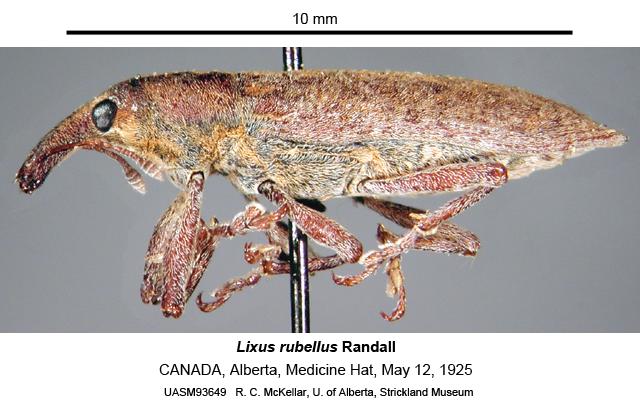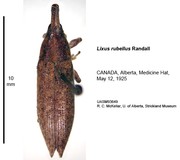Species Details
Lixus rubellus
University of Alberta E.H. Strickland Entomological Museum Read more about this collection »
SeasonalityStrickland Museum specimens (mostly from Alberta) were captured from May-July, with most in June.
IdentificationLeConte (1876) identified this species as being very long and slender in overall shape, and of intermediate size (approx. 8 mm). Its cuticle colour is described as brownish-black (with Strickland Museum collections specimens appearing much closer to reddish-brown), and this is veiled by a sparse coat of very short hairs that become more dense in lateral and ventral positions. The pubescence is grey in colour, but becomes somewhat yellowed in patches - on elytra tips the pubescence becomes so fine that it takes on a powdery appearance. The rostrum of this species is fairly slender, is slightly shorter than the prothorax in length, and bears slender antennae near its tip. The antennae possess a first joint of the funicle (antennal segments between basal scape segment and clubbed tip) that is broader than the second joint. The prothorax is longer than wide, with a gradual anterior taper. Its sides are almost straight, and its back edge forms a broad arc adjacent to each elytron, creating broad medial angle (backwards projection along the midline). A shallow median depression is situated directly ahead of the medial angle. Femora on the legs of this species are slender, and the legs are brown in colour. The distinctive elytral tips are drawn out into extended, divergent points with minor rounding on their tips. Punctures (pits) are fine and dense upon the rostrum, with interspersed large punctures and one large frontal puncture. The prothorax bears minute 'wrinkly' punctures, and some moderately sized shallow ones, while the elytra bear fine 'wrinkly' punctures in tightly-packed rows. Observation of specimens in the Strickland Museum collections suggests that the extended elytra tips, general reduction in pubescence dorsally, and close spacing of elytra punctures are the most diagnostic characteristics for this species.
Scientific Name
Lixus rubellus
Habitat
Mesic (moist) habitats among herbs and shrubs, and in aquatic habitats (Anderson, 2002).
Seasonality
Strickland Museum specimens (mostly from Alberta) were captured from May-July, with most in June.
Identification
LeConte (1876) identified this species as being very long and slender in overall shape, and of intermediate size (approx. 8 mm). Its cuticle colour is described as brownish-black (with Strickland Museum collections…
LeConte (1876) identified this species as being very long and slender in overall shape, and of intermediate size (approx. 8 mm). Its cuticle colour is described as brownish-black (with Strickland Museum collections specimens appearing much closer to reddish-brown), and this is veiled by a sparse coat of very short hairs that become more dense in lateral and ventral positions. The pubescence is grey in colour, but becomes somewhat yellowed in patches - on elytra tips the pubescence becomes so fine that it takes on a powdery appearance. The rostrum of this species is fairly slender, is slightly shorter than the prothorax in length, and bears slender antennae near its tip. The antennae possess a first joint of the funicle (antennal segments between basal scape segment and clubbed tip) that is broader than the second joint. The prothorax is longer than wide, with a gradual anterior taper. Its sides are almost straight, and its back edge forms a broad arc adjacent to each elytron, creating broad medial angle (backwards projection along the midline). A shallow median depression is situated directly ahead of the medial angle. Femora on the legs of this species are slender, and the legs are brown in colour. The distinctive elytral tips are drawn out into extended, divergent points with minor rounding on their tips. Punctures (pits) are fine and dense upon the rostrum, with interspersed large punctures and one large frontal puncture. The prothorax bears minute 'wrinkly' punctures, and some moderately sized shallow ones, while the elytra bear fine 'wrinkly' punctures in tightly-packed rows. Observation of specimens in the Strickland Museum collections suggests that the extended elytra tips, general reduction in pubescence dorsally, and close spacing of elytra punctures are the most diagnostic characteristics for this species.
Life History
Females oviposit individual eggs into notches that they create in stems (Milne and Milne, 1980). Larvae burrow into stems, forming gall-like galleries where they then pupate (Blatchley and Leng, 1916). The adults…
Females oviposit individual eggs into notches that they create in stems (Milne and Milne, 1980). Larvae burrow into stems, forming gall-like galleries where they then pupate (Blatchley and Leng, 1916). The adults emerge to feed on the soft tissues of various plants; often different plants from those used by larvae (Anderson, 1987). There appears to be only one generation per year.
Conservation
Not of concern.
Diet Info
Adult specimens in the Strickland Museum holdings were collected from sage brush (Artemisia sp.), and the leaf of Populus balsamifera (poplar). It is not certain if these were the adult food plants. More compelling…
Adult specimens in the Strickland Museum holdings were collected from sage brush (Artemisia sp.), and the leaf of Populus balsamifera (poplar). It is not certain if these were the adult food plants. More compelling evidence comes from the observations of Lintner (as cited by Webster, 1892), where this species was seen congregating in large numbers upon the flowers of Polygonum amphibium (water smartweed), possibly because this is the food source for the larvae and adults.
Range
Strickland Museum specimens include exemplars from AB, BC, and PEI (Canada).
McNamara (2006) lists additional Canadian occurrences in ON, BC, MB, AB, SK, PQ, and NT. O'Brien and Wibmer (1982) provide US occurrences in…
Strickland Museum specimens include exemplars from AB, BC, and PEI (Canada).
McNamara (2006) lists additional Canadian occurrences in ON, BC, MB, AB, SK, PQ, and NT. O'Brien and Wibmer (1982) provide US occurrences in CT, IL, MA, MI, NY, PA, VT, WI, AZ, CA, ID, OR, UT, WA, MN, MT, NE, NT, SA, SD, and WY.
Notes
O'Brien and Wibmer (1982) list Lixus acutus LeConte 1857 as a junior subjective synonym of this species, but it is not widely used, so it is of little concern.
References
Author
Anderson, R. S.
Title
American beetles.
Publication Date
2002
Pages
783-785
Author
O’Brien, C. W. and G. J. Wibmer
Title
Annotated checklist of the weevils (Curculionidae sensu lato) of North America, Central America, and the West Indies (Coleoptera, Curculionoidea).
Publication Date
1982
Series Title
Memoirs of the American Entomological Institute
Volume
34
Pages
382 pp.
Author
McNamara, J.
Title
Family Curculionidae (snout beetles). Web-based checklist of Canadian beetle species produced by the Canadian National Collection of insects, arachnids, and nematodes.
Publication Date
2006
Author
Webster, F.M.
Title
Food plants of the Lixi.
Publication Date
1892
Series Title
Proceedings of the Entomological Society of Washington
Volume
2
Pages
339-341
Author
Milne L. and M. Milne
Title
National Audubon Society field guide to insects and spiders (North America).
Publication Date
1980
Pages
989 pp
Author
Blatchley, W. S. and C. W. Leng.
Title
Rhynchophora or weevils of North Eastern America.
Publication Date
1916
Pages
682 pp.
Author
Anderson, R. S.
Title
Systematics, phylogeny and biogeography of New World weevils traditionally of the tribe Cleonini (Coleoptera: Curculionidae: Cleoninae).
Publication Date
1987
Pages
740 pp.
Author
LeConte, J. L.
Title
Tribe IV: Cleonini.
Publication Date
1876
Series Title
Proceedings of the American Philosophical Society
Volume
15
Pages
144-160
Author
LeConte, J. L.
Title
Tribe XVIII: Ceutorhynchini.
Publication Date
1876
Series Title
Proceedings of the American Philosophical Society
Volume
15
Pages
267-284
Specimen Information
There are 13 specimens of this Species.
UASM93641 - Lixus rubellus
University of Alberta E.H. Strickland Entomological Museum
Place CollectedCanada: Alberta, Medicine Hat
Collected ByCarr, F. S.
Date Collected1923-06-28
UASM93642 - Lixus rubellus
University of Alberta E.H. Strickland Entomological Museum
Place CollectedCanada: Alberta, Leduc
Collected ByCarr, F. S.
Date Collected1910-06-11
UASM93643 - Lixus rubellus
University of Alberta E.H. Strickland Entomological Museum
Place CollectedCanada: Alberta, Medicine Hat
Collected ByCarr, F. S.
Date Collected1922-06-05
UASM93644 - Lixus rubellus
University of Alberta E.H. Strickland Entomological Museum
Place CollectedCanada: Alberta, Edmonton
Collected ByCarr, F. S.
Date Collected1914-06-28
UASM93645 - Lixus rubellus
University of Alberta E.H. Strickland Entomological Museum
Place CollectedCanada: Alberta, Waterton Lakes National Park, Waterton Lakes
Collected ByCarr, F. S.
Date Collected1926-07-09
UASM93646 - Lixus rubellus
University of Alberta E.H. Strickland Entomological Museum
Place CollectedCanada: Alberta, Medicine Hat
Collected ByCarr, F. S.
Date Collected1921-05-28
UASM93647 - Lixus rubellus
University of Alberta E.H. Strickland Entomological Museum
Place CollectedCanada: British Columbia, Wardner
Collected ByCarr, F. S.
Date Collected1925-07-10
UASM93648 - Lixus rubellus
University of Alberta E.H. Strickland Entomological Museum
Place CollectedCanada: Alberta, Medicine Hat
Collected ByCarr, F. S.
Date Collected1924-06-17
UASM93649 - Lixus rubellus
University of Alberta E.H. Strickland Entomological Museum
Place CollectedCanada: Alberta, Medicine Hat
Collected ByCarr, F. S.
Date Collected1921-05-23
UASM93650 - Lixus rubellus
University of Alberta E.H. Strickland Entomological Museum
Place CollectedCanada: Alberta, Medicine Hat
Collected ByCarr, F. S.
Date Collected1922-06-22
UASM93651 - Lixus rubellus
University of Alberta E.H. Strickland Entomological Museum
Place CollectedCanada: Prince Edward Island
Date Collected1923-07-27
UASM93652 - Lixus rubellus
University of Alberta E.H. Strickland Entomological Museum
Place CollectedCanada: Alberta, Medicine Hat
Collected ByCarr, F. S.
Date Collected1919-06-01
UASM93653 - Lixus rubellus
University of Alberta E.H. Strickland Entomological Museum
Place CollectedCanada: Alberta, Medicine Hat
Collected ByCarr, F. S.
Date Collected1919-06-01



